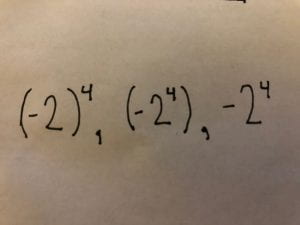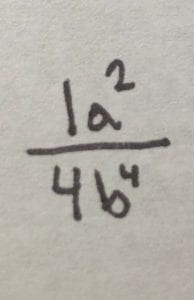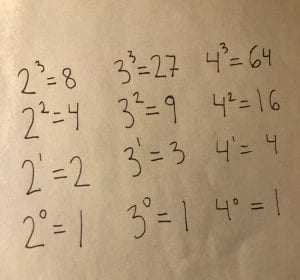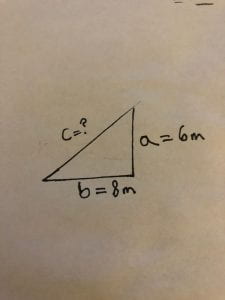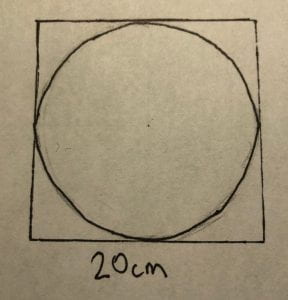Tag: communicationcc
Chemistry 11 – George P – Flame Test CC

Lithium Nitrate:


Copper (II) Nitrate:


Potassium Nitrate:

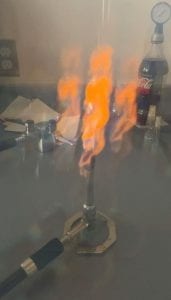
Strontium Nitrate:


Zinc Nitrate:


Calcium Nitrate:


16 Personalities CC Reflection
Physics 11 – George P – Combination Circuits CC Reflection
The Core Competency Reflection below reflects upon how I was successful in accomplishing this Combination Circuits Practice Problem, and understanding the importance of teamwork along with applying a variety of skills will greatly increase your chances of success, while also helping you learn along the way.


F10 – George Plesu – CC Relfection
PHE 10 – George Plesu – Health Unit CC Reflection
Health 2 Substance Abuse Role Play Core Competency Reflection
Everything I know about exponents
2) Describe how powers represent repeated multiplication
In this photo, 2 is the base and 5 is the exponent. This means that 2 is going to be multiplied by itself 5 times, the repeated multiplication for it would be 2 x 2 x 2 x 2 x 2. Both of these expressions would give you the same answer which would be 32 although using exponents would be more efficient and short.
4) Demonstrate the difference between two given powers in which the exponent and the base are interchanged by using repeated multiplication, such as 23 and 32
If we have 23 and 32, although they use the same numbers, since they are interchanged, their products will not be the same because 23= 8 and 32= 9. There are some occasions when bases and exponents are interchanged, then can have the same product, like 42 and 24 both equal 16. In repeated multiplication, our first example would be 2 x 2 x 2 = 8 and 3 x 3 = 9. This is obviously not going to give to the same product because no whole numbered single exponent will give you 8 as a product of the power of 3. 42 and 24 in repeated multiplication would be 4 x 4 = 16 and 2 x 2 x 2 x 2 = 16, the reason why both of these exponents have the same product is because 2 and 4 both have single exponents that can be the product of 16.
6) Explain the role of parentheses in powers by evaluating a given set of powers such as (-2)4, (-24) and -24
In the photo above, (-2)4 in repeated will be (-2) (-2) (-2) (-2) = 16 because -2 is in brackets therefore since -2 is the base, it will be multiplied by itself 4 times. All products with negative bases and even numbered exponents will always be positive while all odd numbered exponents will always have a negative product. This is because (-2) (-2) = 4, then when multiplied again it will be -8. But since both of the numbers being multiplied will be negative, -8 x -2 = 16. For (-24), the repeated multiplication would be -1 x 2 x 2 x 2 x 2 = -16. No matter if it is even or odd, the product of this power will always be negative because there will always be a negative number being multiplied by a positive number. -24 will have the same rule as (-24) since they will both be -1 x 2 x 2 x 2 x 2 in repeated multiplication form.
8) Explain the exponent laws for raising a product and quotient to an exponent
In the example above, since the fraction is in parenthesis with the exponent of 2 outside of the parentheses, we need to multiply each exponent inside the brackets by the exponent outside of the brackets. That means that 4 will become 42 which equals 16 and 8 will become 82 which equals 64. Also, a2 will turn into a4 because we are having a2 x a2 because there is the exponent of 2 outside of the brackets. So we can just add the two exponents using the product law to get a4. We can do the same procedure for the variables on the bottom of the fraction because they are also inside parentheses with the exponent 2 on the outside. Now that we’ve done that, our fraction should look like this.
All we need to do now is subtract the exponents of the same base which means a4 divided by a2 = a2, which will stay on the top because the exponent is still positive. We can also reduce 16/64 to 2/8 and b will stay in the same place because there is nothing else we can do with it besides multiplying it’s previous exponents by the exponent outside of the parentheses. Our final product should look like this
10) Use patterns to show that a power with an exponent of zero is equal to one
When any number except 0, has the exponent of 0, the number will always be 1. There is a simple pattern used to show that this is true, if we look at 23= 8, 22= 4 and 21= 2. If we divide the product of 23 by 2 (the base) we will get the product of 22, if we divide the product of 22 by 2, we’ll get the product of 21. That means that if we divide the product of 21 by it’s base we should get the product of 20 which would be 1 because 2 divided by 2 = 1. This is the same pattern for any number and if we keep dividing the product by the base after 1, we should get product of a negative exponent. For example if we continue from our previous example and do 1 divided by 2, we’ll get 1/2 which is the product of 2-1.
12) Use patterns to explain the negative exponent law
The easiest way to understand negative exponents would be too look at question 10. If we continue the chart with negative exponents after the exponents of 0 we will be able to evaluate negative exponents easily. If we use 2 as an example, we keep dividing the product of 2 to the exponent of something by 2 to get the product of 2 with the e exponent that comes before that. Since we know that 20 = 1, if we divide 1 by 2 we will get 1/2, which is equal to 2-1. If we divide 1/2 by 2 we will get 1/4 which is the product of 2-2. We can keep using this pattern to be able to evaluate any power with a negative exponent.
14) I can identify the error in a simplification of an expression involving powers

The mistake in the first example is that the example above is that the quotient law was used when multiplying the top and bottom part of the fraction before dividing. That means that I subtracted the exponents to make the fraction (2)2/4 instead of (2)10/(4)3. The correct answer would be 1024/64 which we can simply to 16. In the second example, the mistake is that the answer should be positive because (-4)2 = 16. The person who did this mistake most likely thought that (-4)2 = -16 and perused to evaluate the rest of the question which would make the answer negative instead of positive.
16) Determine the sum and difference of two powers
To determine the sum of a power, you need to first figure out what 53 is, then you will find out what 44 is. Then you need to add both products together to fund the sum of the expression, we can’t add 5 and 4 together first because we need to follow the order of operations which states that we need to evaluate exponents before we add the result. For finding the difference of powers, we need to do the same procedure as in the addition problem, although after evaluating the powers, we subtract the two answers together. So if we have 53 – 44 will be 125 – 256 which will equal -131, the sum to 53 + 44 = 38. If we have powers with negative exponents, the same rule will apply although we will be turning the two products into equivalent fractions to either add or subtract to find the difference or sum. For example, if we had 2-5 + 4-2 it would become 1/32 + 1/16. But since we can’t add fractions without a common denominator, we can multiply the numerator and denominator of 1/16 by 2 to give us 2/32. Now that we have a common denominator we can do 1/32 + 2/32 = 3/32. If we are subtracting powers negative exponents we will do the same as when adding but subtract the two products, so if we use the same expression as an example but with subtraction, we would have, 2-5– 4-2 we would have 1/32 – 2/32 = -1/32.
18) Use powers to solve problems (measurement problems)
First Problem Second Problem
In the problem above, it shows that we know that a= 6m and b= 8m. The measurement for c is unknown. To find the length of c, we can use the Pythagorean theorem with says that a2 + b2 = c2. That means that if we want to find the length of c, we can do 62 = 36, plus 82 = 64. So 36 + 64 will equal c2, 36 + 64 = 100, so the square root of 100 is 10 which means that c = 10. Another way we can use exponents in measuring problems can be finding the unshaded area of a square when given the side lengths of both the not shaded and shaded parts. If we have the side length of the white square as 10cm and the shaded square side length as 7cm, we know that when you square the side length of a two dimensional square it will give us the area of the square. So 102 = 100 and 72 = 49. Now that we have both areas, we can subtract them to see what the area of the white square is with the shaded square inside by doing 100 – 49 = 51cm2. You can do the same thing to find the volume of three dimensional cubes if you put the side lengths to the exponents of 3 instead of 2.
Another way you can use powers to solve measurement problems can be by having a circle inscribed in a square and finding the area of the square that is not being covered by the circle. If the square has the side length of the 20cm then you would square it to give you 400. Since the circle is inscribed that means that it’s diameter is also 20cm and it’s radius is 10cm. That means that pi x 102 will give you the area of the circle, which would be approximately 314.16cm2 because 102 equals 100 and 100 x pi can be rounded to 314.16. We also know that the area of the square should be 400cm2 because 202 is 400cm2. If we subtract the two areas we should get 85.84cm2 which is the area of the square that is not being covered by the circle.
20) Applying the order of operations on expressions with powers involving negative exponents and variable bases
In this expression we can start off by using the power law to multiply all the exponents outside of the parentheses by the exponents inside the parentheses. That means that our expression will be (-10)2 (x)6 (y)6 (x)-5(y)5/ [(5)2 (x)4 (y)8]. Now we need to add the exponents on the top half of the fraction because we have two fractions of the same base, so we’ll use the product law to add them together. That means that the top half of the fraction will become (-10)2(x)(y)13. Now we don’t have any negative exponents but if we had any negative exponents on the top half of the fraction we would move them to the place of the denominator so that the exponent would become positive. We can also turn (-10)2 into 100 and (5)2 into 25. Our expression should look like this now, 100(x)(y)13/(25(x)4 (y)6) Now that all exponents are positive, we can use the quotient rule to subtract the exponents. The variable x will go to the denominator of the fraction because the exponent 1 – the exponent 4 will be -3 so we’ll put x on the bottom to turn x-3 into x3. Although we can do the negative exponent last too, I prefer to do it here so that I will not have to put any variables down later. The variable y will only be on the top half of the fraction because the difference between it’s 2 exponents will be y7 because the exponent is positive. Lastly, we will divide 100 by 25 to give us 4. Since we can reduce 100 and 25 into a whole number we need to put 4 on the top of the fraction. So, now that we have done all the steps in the order of operations and followed the exponent law, power law and quotient law, or final answer will be 4y7/x3.
